Coral Nova, neuropsychologist at the Neurological Stimulation Unit (UEN), shares the benefits observed since the incorporation of NeuronUP and examples of sessions for patients with brain injury.
Introduction
Neurorehabilitation is a constantly evolving field. As new knowledge about brain plasticity and the possibilities of functional recovery after neurological damage becomes consolidated, new tools are also being developed that allow us to adapt therapies to each patient’s individual needs. In this context, specialized digital platforms have gained prominence as an effective therapeutic complement, and among them NeuronUP stands out for its versatility and scientific basis.
At the Neurological Stimulation Unit (UEN), for years we have been committed to digital transformation in our interventions and cognitive rehabilitation processes, integrating NeuronUP as one more tool in our approach. In this article we would like to share our experience, from who we are and why we decided to incorporate this platform, to the specific benefits observed in our patients and the success stories that have marked our trajectory.
Overview of the Neurological Stimulation Unit (UEN)
The Neurological Stimulation Unit (UEN) is an organization with more than 25 years of experience in the field of comprehensive neurorehabilitation, with centers in Barcelona, Tarragona and Girona. Initially founded in 1996, UEN has established itself as a reference center in the treatment and intervention of all types of neurological conditions.
Context of intervention at UEN
At UEN we specialize in the field of neurorehabilitation, with structured programs that are adapted to each person’s needs, whether they are in the acute, subacute or chronic phase. The units are located in large residential and social-health centers, which allows us to offer comprehensive care to the person throughout the entire rehabilitation process. The center offers individual, personalized interventions and promotes the participation of the family environment as part of the therapeutic process.
User profile of the Neurological Stimulation Unit (UEN)
The users we treat are mainly adults with acquired brain injury caused by stroke, traumatic brain injury, anoxia or brain tumors, as well as people with spinal cord injuries or neurodegenerative diseases.
In our facilities we care for patients who are at different stages of the rehabilitation process, from acute stages to chronic phases, always adapting the intervention to the stage of recovery the person is in. Our team is trained and qualified to handle cases with different levels of severity, from mild sequelae to complex impairments that require intensive and highly specialized intervention.
Specialization and working philosophy at UEN
UEN is characterized by an interdisciplinary approach that combines the joint work of specialists in rehabilitation medicine, neuropsychology, physiotherapy, speech therapy and occupational therapy, with continuous and rigorous coordination between disciplines.
Our working philosophy is based on person-centered care, always prioritizing functional goals, personal interests and the improvement of the user’s quality of life. A humanistic, ethical and evidence-based model is promoted, in which the person is seen as an active agent in their own recovery process.
Therapeutic approach of the Neurological Stimulation Unit (UEN)
The therapeutic approach of the Neurological Stimulation Unit is based on a personalized, functional and global intervention, focused on each person’s real abilities and aimed at improving their autonomy, social participation and quality of life.
It starts with an exhaustive, interdisciplinary assessment of the user’s cognitive, physical, emotional and functional status, in order to design an individualized therapeutic plan with specific, measurable goals tailored to the real needs of each case.
The center has specialized infrastructure, fully equipped spaces and simulated environments that make it possible to carry out interventions in adapted therapeutic settings and to work on activities of daily living in a controlled and safe way.

Subscribe
to our
Newsletter
Transformation of UEN interventions with NeuronUP
Problems identified before implementing NeuronUP
Before implementing NeuronUP, from the neuropsychology area we identified several needs in the field of intervention:
- Difficulty in adapting the exercises quickly to the patient’s changing cognitive profile.
- Limitations in the objective and automated collection of performance data.
- Growing demand for remote sessions, especially after the COVID-19 pandemic, and a lack of objective follow-up at home.
- Shortage of interactive and playful tools that would motivate patients with low treatment adherence.
Reasons that led us to choose NeuronUP
After evaluating different platform options and digital proposals, we chose NeuronUP for the following reasons:
- Its approach based on cognitive neuropsychology.
- Its broad repertoire of thousands of activities classified by cognitive processes.
- The possibility of designing complete individualized sessions and intervention programs.
- The performance monitoring system and the NeuronUP Score feature, which allows us to objectively measure the patient’s progress.
- The telerehabilitation tool, called NeuronUP2GO, which has enabled us to extend our therapies beyond the center with quality and control.
Changes observed after implementing NeuronUP
Since we integrated NeuronUP into our therapies, we have observed a significant transformation in different areas:
- Our working methodology: We currently structure cognitive sessions by combining digital activities with physical material and designing individualized therapeutic programs according to the neuropsychological profile. Working with NeuronUP allows us to adapt the difficulty of the exercises in real time and to set clearer and more measurable short- and medium-term intervention goals. Likewise, the therapist can analyze and intervene in a more qualitative way, improving therapeutic efficiency and precision.
- The quality of follow-up: Being able to assign tasks to different users makes it possible to carry out more precise monitoring of performance and improvement in each of the activities; in addition, with NeuronUP Score we can quantitatively assess their progress in a systematic way.
- The possibility of remote intervention: NeuronUP has been a key tool for maintaining therapeutic continuity in users who cannot attend with optimal frequency. Our telerehabilitation intervention has become established as an effective therapeutic alternative.
Acceptance of NeuronUP by users and families
One of our most positive surprises has been the good reception of NeuronUP by our users and their families. Although some older users were initially somewhat reluctant to use the computer or tablet, after the first sessions with therapeutic support most of them adapted without difficulty.
The intuitive design, the clarity of the instructions and the playful component have fostered high motivation and treatment adherence. In addition, being able to visualize their progress in NeuronUP Score provides positive reinforcement.
For their part, families especially value the possibility of working from home with dynamic, interactive material and appreciate feeling like an active part of the rehabilitation process.
Benefits of NeuronUP observed in user interventions
Among the benefits we have observed in our clinical practice from the neuropsychology field in our users, we can highlight:
- Improved performance in specific cognitive functions (memory, attention, executive functions).
- Possibility of generalizing skills worked on in some activities.
- Increased level of therapeutic motivation and adherence.
- Facilitates interdisciplinary work by sharing results and progress.
- Improved patient autonomy to carry out cognitive tasks outside the therapeutic setting.
Success stories at UEN thanks to work with NeuronUP
Success story in a patient with brain injury after ischemic stroke
One of the success stories with NeuronUP is that of a 55-year-old man who, after an ischemic stroke, presented moderate language impairment (comprehension and expression), apraxia and alterations in attention and executive functions. These difficulties had a direct impact on his daily autonomy.
From the beginning of the intervention at UEN, the priority objective was to restore functional autonomy in tasks such as cooking: understanding a recipe, going to the supermarket, handling money and following the steps to prepare a meal. To achieve this, as part of his intervention program, language, attention, money management, planning and sequencing skills were worked on in an integrated way through digital activities with NeuronUP.
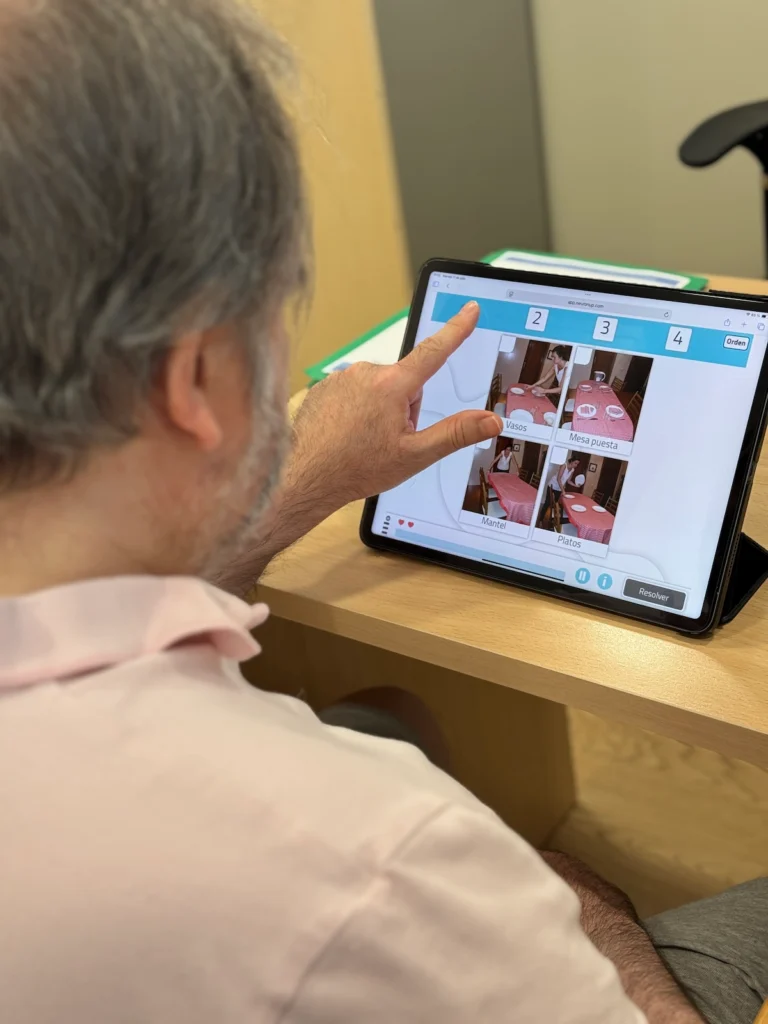
Example of an individual session for this patient with ischemic stroke
Below is a detailed example of a NeuronUP session carried out by the patient using the tablet:
General objective of the session
To stimulate verbal comprehension, the sequencing and planning of everyday actions, and selective attention through function-oriented digital activities.
Part 1: Activation and selective attention (10–15 min)
- Function trained: Selective attention and visual scanning.
- Therapeutic goal: To improve the ability to focus on relevant stimuli among visual distractors, facilitating tasks such as locating specific products in the supermarket or utensils at home.
Activity Twin shapes:
- Function trained: Sustained attention, selective attention and processing speed.
- Therapeutic goal: To train rapid visual discrimination in the presence of similar stimuli, strengthening accuracy and attentional focus in environments with a high load of stimuli.
Part 2: Verbal comprehension and categorization (15 min)
Activity Each word with its family:
- Function trained: Conceptual organization, semantic memory and verbal comprehension.
- Therapeutic goal: To classify words into categories such as food, kitchen utensils, places, body parts, etc., promoting the structuring of thought and the planning of everyday tasks.
Activity Relate noun to image:
- Function trained: Verbal comprehension, semantic association.
- Therapeutic goal: To improve understanding of functional vocabulary related to daily life (food, utensils, objects, clothing).
Part 3: Functional planning and sequencing (20 min)
Activity Order steps of activities:
- Function trained: Temporal sequencing, planning and language.
- Therapeutic goal: To understand and correctly order the steps needed to carry out an everyday activity such as setting the table or making coffee.
Activity Sort the kitchen:
- Function trained: Planning, reasoning, attention, semantic memory.
- Therapeutic goal: To organize and logically arrange the usual products and items found in a kitchen.
Part 4: Money management and functional calculation (10 min)
Activity Exact payments:
- Function trained: Mental calculation, numerical reasoning, functional planning.
- Therapeutic goal: To improve the ability to handle money in real-life situations such as paying in a café or at the supermarket.
Success story in a patient with brain injury after cerebrovascular accident
Another success story in the intervention with NeuronUP at UEN is that of a 43-year-old man who, after a cerebrovascular accident, presents sequelae in the form of attentional deficits, left hemineglect and short-term memory impairment. These difficulties have a direct impact on his autonomy and on his ability to enjoy activities that are meaningful to him, such as reading and writing.
From the beginning of his rehabilitation process, one of the main goals was for him to be able to read fluently again, without visual omissions, and to maintain focus and continuity in reading when faced with novels, newspapers or other long texts.
To this end, the intervention combined compensatory and restorative techniques, with a special focus on stimulating sustained attention, visual scanning and improving immediate recall, using digital tools through the NeuronUP platform.
Example of an individual session for this patient with brain injury
Below is a detailed example of an individual session carried out by the patient on a tablet with specific activities for these goals:
General objective of the session
To stimulate sustained attention, compensatory visual scanning for left hemineglect and immediate memory, in order to facilitate the recovery of functional reading ability.
Part 1: Attentional activation and visual scanning (10–15 min)
Activity Clone:
- Function trained: Selective attention and visual scanning.
- Therapeutic goal: To stimulate visual scanning of the whole space (especially the left side), training compensatory exploration to counteract hemineglect.
Activity Organize the bookshelf:
- Function trained: Sustained attention, visuospatial perception and hemineglect.
- Therapeutic goal: To reproduce the arrangement of objects according to a mirrored (reflected) model, encouraging detailed visual analysis of the entire image to stimulate attention across the whole visual field.
Part 2: Functional reading and immediate memory (15 min)
Activity Text comparison:
- Function trained: Sustained attention, reading comprehension and working memory.
- Therapeutic goal: To read and compare similar texts in order to detect differences, strengthening continuity in reading, comprehension and the ability to hold information for a short period of time.
Activity Written comprehension with questions:
- Function trained: Reading comprehension and immediate memory.
- Therapeutic goal: To read a short text and answer questions to reinforce attention during reading and the ability to retain information in the short term.
Part 3: Hemineglect and visual compensation (15–20 min)
Activity Explore and find:
Function trained: Selective attention, visual scanning.
Therapeutic goal: To locate several specific stimuli among distractors, promoting complete scanning of the screen and strengthening detection of the left field.
- Function trained: Selective attention, visual scanning.
- Therapeutic goal: To locate several specific stimuli among distractors, promoting complete scanning of the screen and strengthening detection of the left field.
Activity Ordered post-its:
- Function trained: Visual episodic memory, divided attention, sequential planning.
- Therapeutic goal: To memorize the positions of notes and reproduce them, promoting complete visual scanning and spatial organization
Part 4: Immediate memory and narrative reinforcement (10–15 min)
Activity Recognition of image sequences:
- Function trained: Working memory, visual attention, visual scanning.
- Therapeutic goal: To memorize and retrieve series of images, working on immediate retention and the focusing ability needed to follow narratives.
Conclusion and reflections
At the Neurological Stimulation Unit (UEN) we work from a comprehensive approach that seeks to optimize each person’s rehabilitation process, adapting resources to their real needs, their preserved abilities and the functional goals that guide the intervention.
In this journey, from the neuropsychology area we continue to commit to incorporating tools that not only stimulate cognitive functions in a specific way, but also promote the transfer of those gains to the patient’s daily life.
NeuronUP, as a digital platform, has been integrated into our practice as a versatile, useful resource that makes it easier to plan more personalized, dynamic and motivating sessions. It allows us to intervene more precisely in specific areas such as attention, memory or executive functions, while always keeping the focus on functionality and the real impact on the person’s autonomy.
We believe that real progress in neurorehabilitation arises from the combination of continuous updating in evidence-based techniques, the integration of useful technological tools and human support centered on each individual case.
In this line, the incorporation of NeuronUP has allowed us to design more structured interventions, tailored to each user’s cognitive profile and with greater control over the progression and difficulty of the exercises. This tool has helped improve the effectiveness of our sessions by enabling more intensive, precise and motivating training, thus optimizing the use of therapeutic time and strengthening specific cognitive areas in greater depth.
If you enjoyed this article on the digital transformation of neurological therapies at UEN thanks to NeuronUP, you will surely be interested in these NeuronUP articles:
“This article has been translated. Link to the original article in Spanish:”
Transformación digital de terapias neurológicas en la UEN gracias a NeuronUP
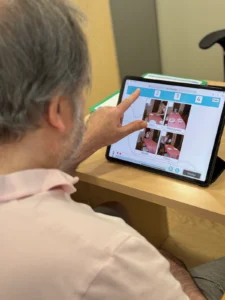
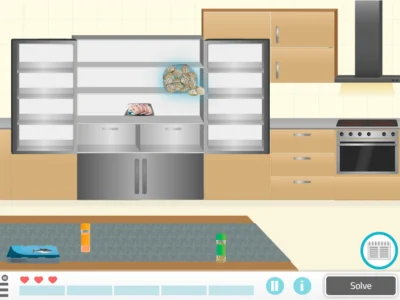
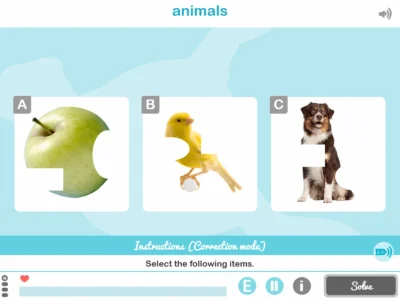
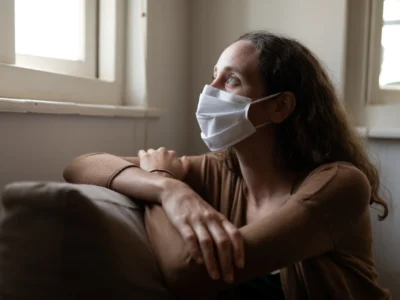

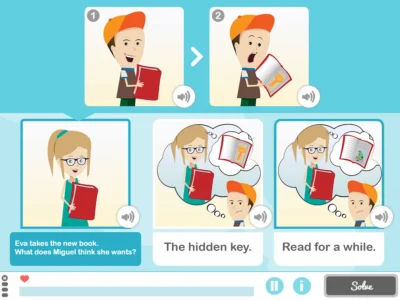
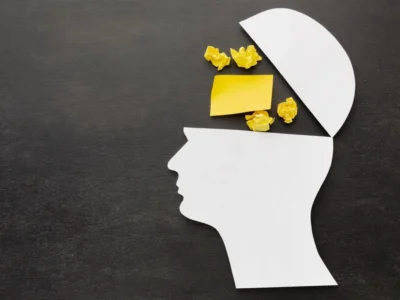
 Feasibility study of neuromodulation and cognitive training for post-COVID fatigue
Feasibility study of neuromodulation and cognitive training for post-COVID fatigue
Leave a Reply